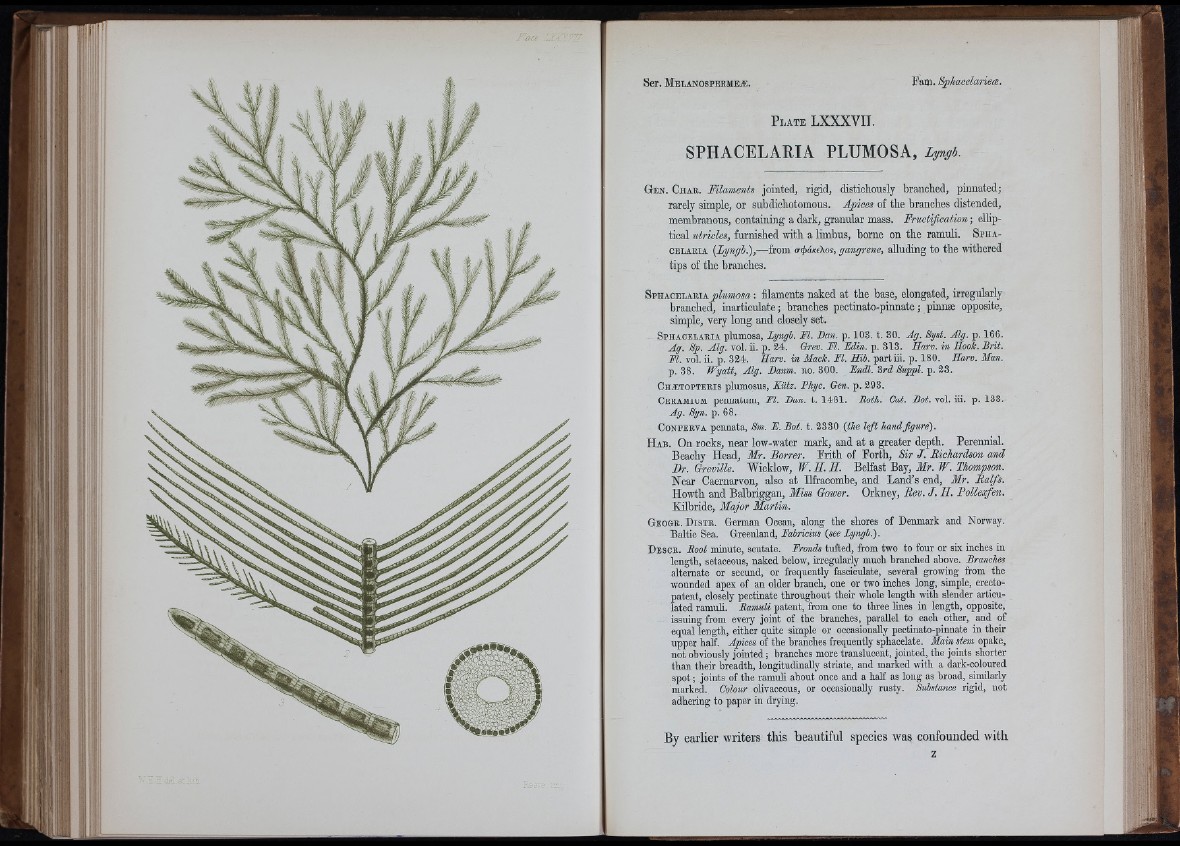
P l a t e LXXXVII.
SPHACELARIA PLUMOSA, Lyngb.
G en. Chae. Filaments jointed, rigid, distioliously branched, pinnated;
rarely simple, or subdichotomous. Apices of the branches distended,
membranous, containing a dark, granular mass. Fructification; elliptical
utricles, furnished with a limbus, borne on the ramuli. Seha-
celaela [Lyngh) ,—from o-cjiaKEXos, gangrene, alluding to the withered
tips of the branches.
Sphacelaeia yjfomo«« ; filaments naked at the base, elongated, irregularly
branched, inarticulate; branches pectinato-pinnate; pinnæ opposite,
simple, very long and closely set.
S p h a c e l a e ia plumosa, lyngh. PI. Ban. p. 103. t. 30. Ag. Syst. Alg. p. 166.
Ag. Sp. Alg. vol. Ü. p. 24. Grev. PI. Edin. p. 313. Harv. in Hook. Brit.
PI. vol. ii. p. 324. Harv. in Mack. PI. Hib. partiii. p. 180. Harv. Man.
p. 38. Wyatt, Alg. Banm. no. 300. Endl. 3rd Suppl. p. 23.
C h æ t o p t e e i s p lum o su s , Kiitz. Phyc. Gen. p . 2 9 3 .
Ce e a m iü m pennatum, PI. Ban. t. 1481. Roth. Cat. Bot. vol. iii. p. 133.
Ag. Syn. p. 68.
C o n f e ev a p e n n a ta , Sm. P. Bot. t. 2 3 3 0 (the left hand figure).
H ab. On rocks, near low-water mark, and at a greater depth. Perennial.
Beachy Head, Mr. Borrer. Frith of Forth, Sir J. Richardson and
Br. Greville. Wicklow, W. H . H. BeKast Bay, Mr. W. Thompson.
Near Caernarvon, also at IKracombe, and Land’s end, Mr. Balfs.
Howth and Balbriggan, Miss Oower. Orkney, Bev. I . H. FoUexfen.
Eolbride, Major Martin.
G e o o e . D i s t e . German Ocean, along the shores of Denmark and Norway.
Baltic Sea. Greenland, Eabrieius (see lyngh.).
D e s c e . Boot minute, scutate. Eronds tufted, from two to four or six inches in
length, setaceous, naked below, irregularly much branched above. Branches
alternate or secund, or frequently fasciculate, several growing from the
wounded apex of an older branch, one or two inches long, simple, erecto-
patent, closely pectinate throughout their whole length with slender articulated
ramuli. Ramuli patent, from one to three lines in length, opposite,
issuing from every joint of the branches, parallel to each other, and of
equal length, either quite simple or occasionally pectinato-pinnate in their
upper half. Apkes of the branches frequently sphacelate. Main stem opake,
not obviously jointed ; branches more translucent, jointed, the joints shorter
than their breadth, longitudinally striate, and marked with a dark-coloured
spot ; joints of the ramuli about once and a half as long as broad, similarly
marked. Colour olivaceous, or occasionally rusty. Substance rigid, not
adhering to paper in drying.
By earlier writers this beautiful species was confounded with
n